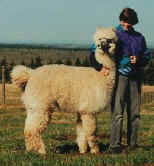|
... |
 |
Farm Main Page |
|
.... |
 |
Alpaca Homepage |
|
.... |
 |
CanCam Fibre Co-op |
|
|
 |
Alpaca Information |
|
.. |
 |
Alpacas for Sale |
|
|
 |
Alpaca Fibre |
|
.... |
 |
Alpacas in Canada |
|
.... |
 |
Alpaca Links |
|
.... |
| |
From our start with alpacas in 1995, Fibre Works Farm has emphasized premium fibre
production. We also believe that correct conformation is important, much like the sturdy
hanger supporting the gorgeous designer coat. Our breeding program is focused on
developing structurally correct alpacas with the elite fibre characteristics of fineness,
uniform diameter, soft hand, bold even crimp, lustre and density. We have chosen our
bloodlines from Canada, the US, Australia and South America with these specific breeding
goals in mind.
Alpacas originated in South America where they were
domesticated by the native people from the wild vicuna, as much as 5000 years ago. The
sparse conditions of the alpacas' existence in the Andean highlands have blessed
them with a hardy disposition and the ability to tolerate harsh climactic conditions.
Their fine fibre provides excellent insulating qualities, both for the alpacas and in
garments made from their fibre. Alpaca fibre also tends to shed water, another benefit for
survival as well as an attractive feature in any textile.
Alpacas are quite easy to manage as they are
generally calm and docile animals, and quite intelligent. Their herding instinct is fairly
strong and they usually use a communal dung pile. Alpacas are ruminants
that do well on reasonable quality summer pasture. They like to browse and
thoroughly enjoy cleaning up on scrub and shrubs. In general, alpacas are
efficient feed converters so in the winter, good clean hay, free choice mineral supplements
and the occasional grain or feed supplement will meet their needs. Fencing should be
sturdy and around 5 feet high but is more to keep potential predators out than to
withstand challenges by the alpacas. Alpacas may also need toe nail trimming from time to
time, annual vaccinations and worming as well as annual shearing.
While alpacas are quite new to Canada with the first
major import arriving in 1992, a thriving and ever expanding breeding stock
industry has developed. In addition, local fibre mills are gaining expertise in spinning
the raw fibre into delightful yarn and a cottage textile industry is well on its way.
The Canadian Alpaca Breeders Association (CABA) and the Canadian Llama and Alpaca Association (CLAA)
and a number of regional clubs provide wonderful support for alpaca breeders and fibre
producers with educational material, seminars, marketing support and a growing show
circuit.
Fibre Works Farm also offers 'before' and
'after' sales consultation to help breeders and fibre producers maximize the potential
from their animals. We have been very involved with fibre pooling and fibre co-op
development and continue to work on strengthening the fibre aspect of the Canadian Alpaca
industry. |
 |
|
|
| |
|